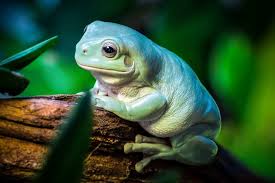FROG WHITE’S TREE (Litorea caerulea)
$70.00
Full Description
Here is a complete care guide for the White’s Tree Frog (Ranoidea caerulea), also known as the Dumpy Tree Frog or Australian Green Tree Frog. This species is a favorite among amphibian keepers for its calm temperament, hardiness, and expressive personality.
White’s Tree Frog Care Guide
Species Overview
| Trait | Description |
|---|---|
| Common Names | White’s Tree Frog, Dumpy Tree Frog, Australian Green Tree Frog |
| Scientific Name | Ranoidea caerulea (formerly Litoria caerulea) |
| Origin | Australia, New Guinea |
| Lifespan | 10–20 years (with proper care) |
| Size | 3–5 inches (7.5–13 cm) |
| Temperament | Docile, calm, handleable with care |
| Best For | Beginner to Intermediate keepers |
Enclosure Requirements
Enclosure Size
| Stage | Minimum Tank Size |
|---|---|
| Juvenile | 10–15 gallons |
| Adult | 18x18x24″ or 20+ gallons tall |
Arboreal species — vertical space is more important than floor space.
Substrate Options
| ✅ Safe Options | ❌ Unsafe Options |
|---|---|
| Coco fiber (Eco Earth) | Gravel |
| Sphagnum moss | Sand |
| Reptisoil | Bark chips (can cause impaction) |
| Leaf litter (top layer) | Paper towels (temporary only) |
Maintain moderate substrate moisture — not soggy.
Decor & Enrichment
| Decor Item | Purpose |
|---|---|
| Vertical climbing branches | Climbing & exercise |
| Cork bark, bamboo, PVC | Resting areas |
| Live or fake plants | Hiding and humidity |
| Water dish (shallow) | Soaking & hydration |
Provide plenty of cover to reduce stress.
️ Temperature & Humidity
| Parameter | Ideal Range |
|---|---|
| Day Temperature | 75–85°F (24–29°C) |
| Night Temperature | 65–75°F (18–24°C) |
| Humidity | 50–70%, misted 1–2× daily |
| Water Dish Temp | Room temp, dechlorinated |
Use a thermostat-controlled heat mat or low-watt basking light if needed.
Do not let humidity drop below 40%.
Avoid heat rocks — frogs can get burned.
Lighting
-
UVB lighting is optional, but low-level UVB (2.0 or 5.0) is beneficial for long-term health.
-
12-hour light/dark cycle.
-
Provide a daylight LED or plant grow light if using live plants.
️ Diet & Feeding
Feeder Insects
| Feeder | Notes |
|---|---|
| Crickets | Staple diet |
| Dubia roaches | Nutritious, easy to gut-load |
| Silkworms | High in moisture and protein |
| Black soldier fly larvae | Good calcium source |
| Waxworms | Occasional treat (high fat) |
| Hornworms | Moisture-rich treat |
Feeding Frequency
| Age Group | Frequency |
|---|---|
| Juveniles | Daily |
| Adults | Every 2–3 days |
Supplements
| Supplement Type | Frequency |
|---|---|
| Calcium (no D3) | Every feeding |
| Calcium + D3 | 1–2× per week |
| Multivitamin | 1× per week |
✅ Always gut-load feeders 24 hours before feeding.
Cleaning & Maintenance
| Task | Frequency |
|---|---|
| Spot clean waste | Daily |
| Replace water | Daily |
| Full substrate change | Monthly |
| Deep tank clean | Every 4–6 weeks |
Use dechlorinated or spring water only — tap water can harm amphibians.
✋ Handling Tips
| DO | DON’T |
|---|---|
| Wash hands before & after | Handle with dry or dirty hands |
| Keep sessions short (5–10 min) | Squeeze or drop them |
| Gently scoop with both hands | Grab from above or by limbs |
| Keep them close to the surface | Let kids handle unsupervised |
Frogs absorb chemicals and oils through their skin — be gentle and clean!
Common Health Issues
| Symptom | Possible Cause |
|---|---|
| Dry skin, wrinkling | Low humidity |
| Lethargy, not eating | Cold temps, stress, parasites |
| Redness on belly/legs | Bacterial infection |
| Bloating, floating | Impaction or metabolic issue |
| Pale/gray skin patches | Natural shedding (normal) |
Consult an exotics vet if symptoms persist.
✅ Quick Care Summary
| Category | Key Info |
|---|---|
| Enclosure | 18x18x24″ tall for adults |
| Temperature | 75–85°F day, 65–75°F night |
| Humidity | 50–70% (mist daily) |
| Substrate | Coco fiber + moss |
| Diet | Insects + supplements |
| Handling | Gentle, infrequent, clean hands |
| Lighting | Optional UVB + day/night cycle |

